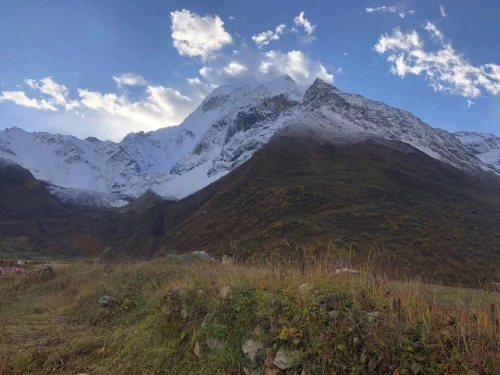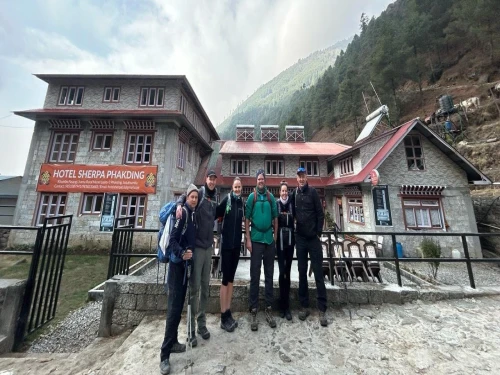Number of Camps on Mount Everest : A Comprehensive Guide

Introduction
Mount Everest is the tallest mountain on Earth, standing proudly at 8,848.86 meters (29,030 feet). Situated in Khumbu, Solukhumbu is an exclusive dream for the bug-ridden adventurers worldwide. Yet to stand at the top of Everest is not a feat for everyone. The untamed terrains of Everest test one’s fortitude, patience, and spirit in an agonizing and yet fulfilling way.
Summiting Everest stands in a class of its own for many. Not only must they be athletically fit and well trained, but climbers must also have the technical skills, equipment, and expert help, along with support from Sherpas highly familiar with the mountain. The climb itself is usually a two-month trip. It involves the most adventurous stages, like a flight from Kathmandu to Lukla, then a trek to Everest Base Camp, and finally standing on the summit by passing through four camps along the way.
Basically, there are two main base camps from which climbers start the Everest summit: South Base Camp and North Base Camp. One goes through Tibet from the North Face of Everest, known as the North Col Route. The other popular way of reaching the summit goes through the Nepal South Face, which is the South Col Route. Most of the climbers prefer the South Col or South Base Camp because it is the best and easiest.
Mount Everest South Base Camp
The South Base Camp in Nepal, situated at an elevation of 5,364 m (17,598 feet), is the starting point for the majority of Everest summit attempts via the southern route. Being more favored and accessible than the North Base Camp, it enjoys a large turnout during peak mountaineering seasons. From here, mountaineers work their way up to the top through four principal camps.
The entire distance from base camp to summit is some 20.5 km and takes many weeks: almost a month going up and down the mountain a few times for acclimatization. Every camp becomes more difficult in terms of weather and the availability of oxygen. Danger starts after Camp 4 and into the “Death Zone,” i.e., above 8,000 meters, where time allocation needs to be minimized for survival from an almost guaranteed death, down to reaching the world's highest peak.

Camp 1 (6,065 m / 19,900 ft)
- Elevation gain 701 m| Distance 6.4 km| Time 4 – 6 hrs
- Located just above the dangerous Khumbu Icefall
- trouble of deep crevasses and ice halls
- Temperature- 15 °C to 10 °C
- Wind 10 – 20 km/ h
- Stay 1 – 2 days for rest and adaptation
Camp 2( 6,400 m/ 21,000 ft)
- Elevation gain 335 m| Distance 4 km| Time 3 – 4 hrs
- Safe but cold and windy
- Trouble with altitude sickness, hypoxia, and frostbite
- Temperature- 15 °C to 0 °C
- Wind 15 – 25 km/ h
- Stay 5 – 7 days, constantly moving between Camp 1 and Camp 2
Camp 3( 7,162 m/ 23,500 ft)
- Elevation gain 762 m| Distance 2.5 km| Time 4 – 7 hrs
- On the steep Lhotse Face
- Veritably delicate rise with icy pitches
- Temperature-10 °C to-25 °C
- Wind 20 – 30 km/ h
- Stay 13 – 15 days, training, and moving back to the lower camps
Camp 4( 7,925 m/ 26,000 ft)
- Elevation gain 763 m| Distance 1.2 km| Time 4 – 6 hrs
- Located in the “ Death Zone ”
- Veritably high threat, thin oxygen, dangerous rainfall
- Temperature-15 °C to-30 °C
- Wind 30 – 50 km/ h
- Stay 1 – 2 days before peak drive
Camp 4 to Summit( 8,848.86 m/ 29,032 ft)
- Elevation gain 898.86 m| Distance 1.7 km| Time 8 – 12 hrs( plus 5 – 6 hrs to descend)
- The utmost dangerous part of the rise
- Threat of extreme cold wave, frostbite, altitude sickness, and death
- Temperature-20 °C to-40 °C
- Wind 50 – 100 km/ h
- Max stay in the Death Zone is 48 hours
North Base Camp (Tibet) to Everest Summit
It is situated in Tibet at an elevation of 5150 m Everest North Base Camp is far away from the din and crowd of South Base Camp, thereby being a suitable option for climbers seeking shelter and nature. Climbers move through five principal camps on the way from base camp, swinging for a total distance of about 20 km from the summit. The rest of the route is difficult weather; the rest are steep climbs with high winds and low oxygen after Camp 3. Each camp is a big help in assisting the climbers in acclimatizing to this extreme altitude and preparing for the downright dangerous final summit push.

Intermediate Camp (6,050 m/19,849 ft)
- Elevation Gain 900 m | Distance
- 4 km | Time 6–7 hrs
- First stop after Base Camp
- Weather: Windy, cold, chance of snow
- Temperature: 15°C to 10°C
- Stay only 1 night before moving up.
Advanced Base Camp – ABC (6,485 m/21,276 ft)
- Elevation Gain 420 m | Distance
- 92 km | Time
- 6 hrs
- One of the loftiest base camps in the world
- Used for rest and high-altitude training
- Temperature: -20°C to 0°C
- Stay 2–3 days.
Camp 1/North Col (7,066 m/23,182 ft)
- Elevation Gain 581 m | Distance
- 48 km | Time 5–6 hrs
- Located above East Rongbuk Glacier
- Rovers use fixed ropes and cross crevasses.
- Temperature: -10°C to -25°C
- Weather: Cold, windy, snowstorms possible
- Stay 5–6 days with passages back to ABC.
Camp 2 (7,700 m/25,262 ft)
- Elevation Gain 634 m | Distance
- 3 km | Time
- 5 hrs
- Veritably steep and snowy crests
- Wind and low oxygen make this rise tough.
- Temperature: -15°C to -30°C
- Stay 2–3 days.
Camp 3 (8,300 m/27,231 ft)
- Elevation Gain 600 m | Distance
- 75 km | Time
- 6 hrs
- Final camp before peak drive
- Located in the “Death Zone”
- Exposed, windy, and freezing conditions
- Temperature: -20°C to -35°C
- Stay short; rest before the peak rises.
Camp 3 to Summit (8,848.86 m/29,032 ft)
- Elevation Gain 548.86 m | Distance
- 32 km | Time 10–13 hrs
- Extremely delicate section with low oxygen
- Wind speeds are high; temperatures drop to -40°C.
- Loftiest threat zone—quick peak and descent demanded
- Temperature: 25°C to -40°C
- Danger: Death Zone, frostbite, prostration
Why Are There So Many Camps on Mount Everest?
Mount Everest is extremely high, and climbing it is very hard. Camps are needed for many important reasons:
- Acclimatization: Being present at different elevations provides time for the body to rearrange itself accordingly to the lowering levels of oxygen.
- Safety: Camps are safe stations to take shelter from storms or any other emergencies.
- Step-by-step process: When climbing by stages, this reduces tiredness and altitude sickness.
- Rest and recovery: Climbers rest, eat, and recuperate their energies at the camps before moving forward.
- Storage of equipment: Additional supplies and gear are stored at camps so climbers can climb lighter.
- Wait for Weather: Climbers will typically hang out at Camp for a day or two or until the weather clears before moving upwards.
- Final summit preparations: The last camp is for final mental and physical regimens before the finale.
In Conclusion
The various camps spread throughout Mount Everest assist climbers in safely reaching the summit. On the Nepalese side, there are four major camps between Base Camp and the top of the mountain. On the Tibetan side, there are five major camps above the base camp.
Each camp is established a bit farther, thus enabling climbers to rest, compensate for air thinness, and move on to another very tiring piece of climbing. These camps are important as they greatly reduce altitude sickness and allow the climbers to adapt slowly to adverse environments. No matter whether the South or North route is chosen, these camps will be crucial in aiding the much safer and successful journey to Everest.
Reserve your place with Mount Glory Treks; experienced professional guides, thorough acclimatization plans, and your comfort come first at Mount Glory Treks.




 4 reviews
4 reviews.webp)





